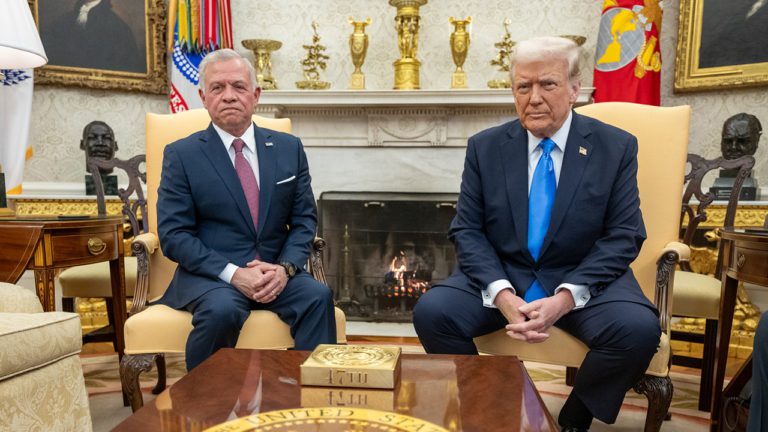
The scene in the White House on February 11 was startling. King Abdullah II of Jordan listened to President Donald Trump ramble on about how the United States will grab and develop the Gaza Strip and send its two million Palestinians to Egypt, Jordan, and other lands. And it was about much more than Jordan-US relations and Trump’s ideas on how to manage Gaza. It was a gruesome peek into the possible future of the Middle East—if the scheme works—and the role of big powers in it.
More than any other recent event in the Middle East, this meeting’s content, body language, and implications exposed the deeper Arab and Middle Eastern existential realities that are largely ignored by the superficial analyses of the western and Israeli mainstream media and political elites. These existential realities relate to the behavior and condition of Jordan and other Arab states, the Palestinians, Israel, and the United States in the region.
All Arab states and leaders should draw the correct conclusions from this episode which, like all Trump events, combined drama, investment and profit opportunities, and colonial disdain for countries that do not comply with American dictates. The moment ultimately clarified seven issues that are central to Jordan’s wellbeing and the future of the region:
- The fragility and vulnerability of all Arab states;
- The contested sovereignty of all Arab states that rely on foreign assistance;
- The limits of political or strategic alliances with the United States, and perhaps with other big powers;
- The frightening public and global manifestation of a new, explicit colonial surge by the United States;
- The differing attitudes toward the power of Arab public opinion;
- The reality that the United States can dictate policy to Israel when it wishes; and,
- The century-long invisibility of the Palestinian people and their right to national self-determination.
All these realities and conditions reared their ugly heads during the Oval Office encounter between President Trump and King Abdullah and deserve to be recognized more explicitly by Arab leaders and publics. The global mainstream media also should acknowledge the damage it does by reporting on the Zionist-Israeli-narrated fantasyland on display in Gaza and the occupied West Bank, rather than the actual condition of suffering by real people and governments in the Middle East.
Today’s reality is certainly the most challenging moment that King Abdullah has faced in his 26 years on the throne, an existential moment whose outcome could determine his incumbency and the future of the Hashemite Kingdom itself. He showed that he has learned much in the past quarter century about how to navigate and survive the turbulent Jordan-Palestine and wider Middle Eastern environment that defines his identity, throne, and state.
But these are new and different times, where old rules of state behavior no longer apply. This is the age of a Zionist-Israeli genocide that benefited directly from American and British complicity and indirectly from Arab state complacency, while most people in the region and the world opposed it. Arabs and others should now appreciate that this region has become merely a wading pool for the United States and other big powers, who show little genuine commitment to anything there beyond Israel’s security, access to oil and gas, and the flow of Arab surplus investments to the West. Perhaps the only new element in this grim picture is the sudden American priority interest in real estate developments on Arab beachfronts such as that proposed for Gaza by President Trump.
King Abdullah’s White House moment allowed President Trump to articulate all these points in less explicit terms. This was a public relations session, not a formal negotiation, so both leaders spoke in generalities. King Abdullah, like every Jordanian king since the 1940s, rightly met with the American president to learn more about his ideas; he also did not give substantive replies, perhaps because he needed first to meet with Arab leaders to learn if he had enough backing to resist US pressures to host Palestinian refugees from Gaza.
Jordan’s weakness has always been that it is too small and poor to stand up to foreign threats and pressures on its own, and always needed the financial and security support of others. Its strength has always been that it consistently generated that external support, from the United Kingdom and the United States historically, but also from Saudi Arabia and Gulf Arab states, the Europeans, Japan, and others. Its dilemma today is that its traditional balancing act has pretty much run its course, and it finds itself at a moment of reckoning.
The Hashemite Kingdom’s main danger is due to its fragility and vulnerability. It was always able to maintain domestic calm and development thrusts because it allowed most of its citizens to live decently, with constantly expanding access to social services, jobs, education, housing, and other essentials. This precluded serious citizen political participation or accountability in governance, which were managed by the royally-guided security, tribal, and business elites. The constant tension in society that is now uppermost in King Abdullah’s mind has been the Jordanian population’s support for pan-Arab, anti-colonial, and anti-Zionist movements since the 1930s, while the bedrock of Jordan’s current stability since just before his rule began has been close ties with the United States and cooperation with Israel.
Both American and Israeli links are now possible liabilities for Jordan, at a time when its population suffers worsening socio-economic conditions that are beyond the ability of the state to resolve in critical arenas like jobs, family income, and water. The great historical fracture in Jordan has been that a paternalistic developmental state that consistently improved the lives of its citizens from the 1940s to the 1990s has not been able to sustain that legacy for recent generations, leading to deteriorating living conditions and diminishing hopes for millions. The unemployment rate in the third quarter of 2024 was about 21.5 percent and the informal labor rate was around 50 percent. Youth unemployment in 2023 was about 41 percent. The state needs nearly $4 billion annually to help cover its core spending needs, and usually gets it from friends and allies—but at the cost of foreign debt being 114 percent of GDP. This does not include internal borrowing from state and private institutions.
If the United States, Jordan’s biggest donor, decides to squeeze the Jordanian government, the pain would be hard to weather.
If the US government now succeeds in forcing Jordan to accept Palestinians from Gaza, that is likely to open the door for Israel to try and expel Palestinians from the occupied West Bank. Regardless of their origin on the west or east bank of the Jordan River, Jordanians today are vehemently opposed to their government being complicit in US-Israeli-engineered ethnic cleansing of Palestinians.
It is not clear how much leeway King Abdullah has in order to resist US-Israeli pressures to resettle Palestinians from Gaza. Jordan is in a very difficult situation because of decisions made over the past century by its own power elite, Israelis, and British and American colonial officials. Trump has now clarified that stressful combination that tests the Jordanian leadership as it has never been tested before.
The views expressed in this publication are the author’s own and do not necessarily reflect the position of Arab Center Washington DC, its staff, or its Board of Directors.
Featured image credit: Flickr/The White House

